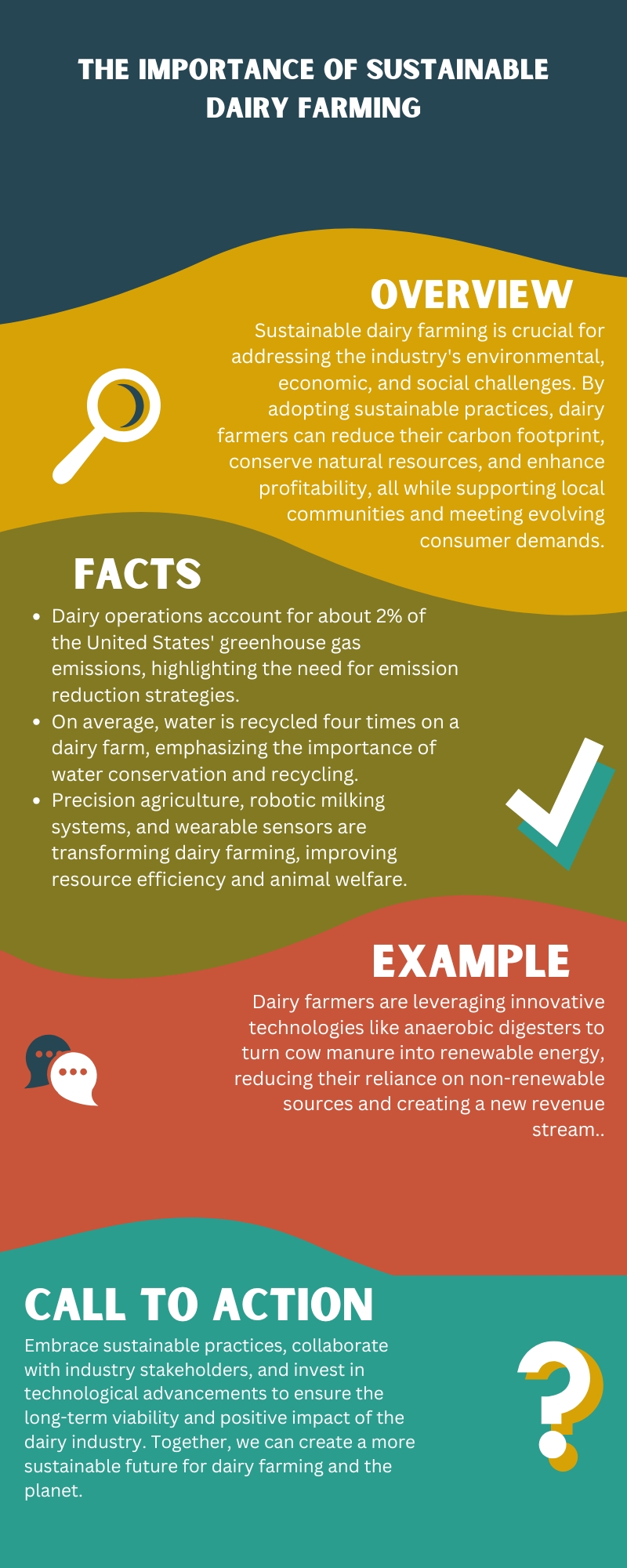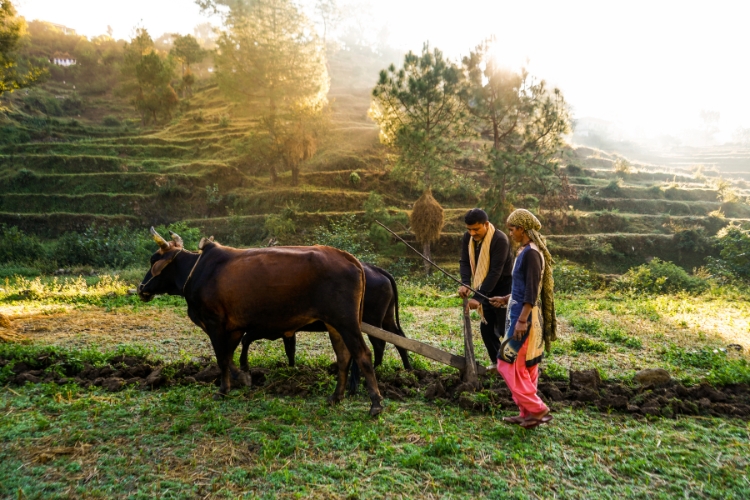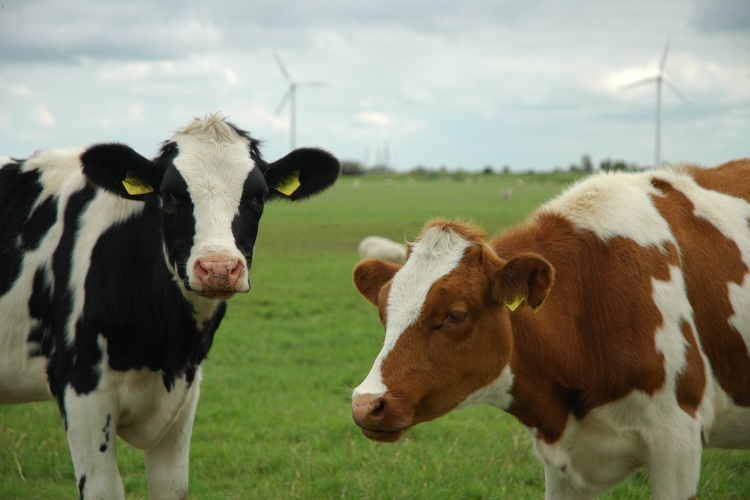Sustainability in dairy farming refers to practices that strive to meet the industry’s current requirements while preserving the ability of future generations to meet their own.
This includes tackling environmental, economic, and social issues such as lowering greenhouse gas emissions, protecting natural resources like water and land, ensuring animal welfare, and encouraging community involvement.
Sustainable dairy farming goes beyond environmental protection; it encompasses economic profitability and social responsibility. Together, these elements form a comprehensive and resilient agricultural system.
Dairy farming is under immense pressure when it comes to sustainability: consumer expectations for environmentally sustainable milk production and animal welfare are rising. In addition, retailers and milk processors are introducing sustainability reporting and demanding improvements.
Carbon credits are also gaining importance, and regulations are becoming stricter. In this context, optimizing nutrient use efficiency emerges as a critical strategy for dairy farmers to enhance sustainability, mitigate environmental impact, and meet evolving market demands.
Sustainable Dairy Farming Practices and their Benefits
| Practice | Benefits |
|---|---|
| Greenhouse Gas Emission Reduction | – Lowered carbon footprint
Mitigated climate change impact |
| Water Conservation and Recycling | – Reduced water usage
Improved water quality |
| Sustainable Land Management | – Protection of biodiversity
Prevention of deforestation and land degradation |
| Soil Health and Nutrient Management | – Replenished soil nutrients
Increased soil carbon sequestration |
| Manure Management | – Renewable energy generation
Crop fertilization and animal bedding |
| Feed Management | – Reduced methane emissions
Improved feed efficiency |
| Precision Agriculture | – Optimized resource utilization
Minimized environmental impact |
| Robotic Milking Systems | – Enhanced animal welfare
Reduced labor and energy costs |
| Wearable Sensors and Data Analytics | – Real-time monitoring of cattle health and behavior
Improved productivity and welfare |
Environmental Challenges Facing Dairy Farming
1. Greenhouse Gas Emissions
Dairy operations emit greenhouse gases that contribute significantly to climate change, primarily methane (CH4) and nitrous oxide (N2O).
The dairy industry accounts for about 2% of the United States’ greenhouse gas emissions. Efforts to reduce these emissions include installing methane capture equipment in barns, improving feed efficiency to reduce methane production from enteric fermentation in cows, and optimizing waste management procedures to reduce nitrous oxide emissions.
2. Water Use and Quality
On average, water is recycled four times on a dairy farm. It’s used to cool down fresh milk, provide drinking water for the herd, clean off machinery and equipment, flush out manure from barns, and finally, water crops. To reduce water contamination, dairy farms use best management practices (BMPs) such as vegetative buffer strips, cover crops, and effective nutrient management strategies.
These techniques serve to prevent fertilizer runoff, sedimentation, and infections from entering water bodies, hence preserving water quality and protecting aquatic ecosystems.
3. Land Use and Biodiversity
Sustainable Dairy Farming Practices
1. Soil Health and Nutrient Management
Importance of Healthy Soil
- Essential for dairy farmers and a sustainable planet.
- Supports long-term productivity and ecosystem health.
Regenerative Agriculture Practices
- Cover Crops:
- Planted during winter to protect soil from erosion.
- Replenishes nutrients naturally, enhancing soil fertility.
- Low-Till or No-Till Field Practices:
- Minimizes soil disturbance.
- Helps maintain soil structure, reducing erosion and improving water retention.
- Natural Fertilizers (e.g., Manure):
- Enriches soil with organic matter and nutrients.
- Promotes a balanced nutrient cycle in the ecosystem.
Benefits of Sustainable Soil Management
- Replenishes essential soil nutrients.
- Reduces nutrient runoff into waterways.
- Increases soil longevity and resilience.
- Maintains soil carbon stocks, supporting carbon sequestration and reducing greenhouse gas emissions.

2. Manure Management
Energy Needs on Dairy Farms
- Energy powers essential facilities and equipment.
- Cows produce manure, which contains valuable, reusable energy.
Anaerobic Digesters: Converting Manure to Renewable Energy
- How it Works:
- Manure is processed in an anaerobic digester, converting it into biogas.
- This biogas can then be used as renewable energy on the farm or sold back to the grid.
- Benefits:
- Provides a sustainable alternative to nonrenewable natural gas.
- Reduces dependency on fossil fuels, supporting energy sustainability.
Additional Uses of Manure
- Fertilizer:
- Rich in nutrients, manure can be reused to fertilize crops.
- Animal Bedding:
- When dried, manure can be repurposed as bedding for animals, creating a closed-loop resource system on the farm.
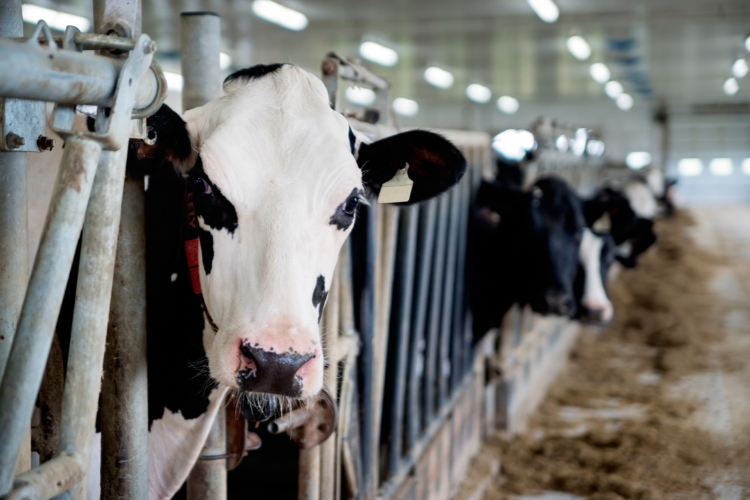
3. Feed Management and Reducing Methane Emissions
Some call cows the ultimate recyclers, all thanks to their hearty stomachs. Because cows are ruminants, which means they have four different parts to their stomach, they can digest food that humans cannot, often diverting it from a landfill in the process.
Dairy farmers are exploring ways to reduce their herd’s carbon footprint, like using feed additives and optimizing feed rations. Healthy, comfortable cows utilize feed more efficiently, which lessens the emissions per pound of milk.
4. Water Conservation and Recycling
Reusing water is a common sustainable farming practice. Water that is used to cool milk, for instance, may later be used to clean barns before being captured and used to irrigate crops.
Dairy farmers may even reclaim and reuse community wastewater — they just ensure it’s treated properly first.
5. Renewable Energy
As dairy farmers continue to focus on using renewable energy, solar panels have begun to pop up on dairy farms around the country.
Many dairy farmers have found powering their farms with sunlight to be an efficient way to reduce their electricity needs, especially when solar energy peaks from May through August.
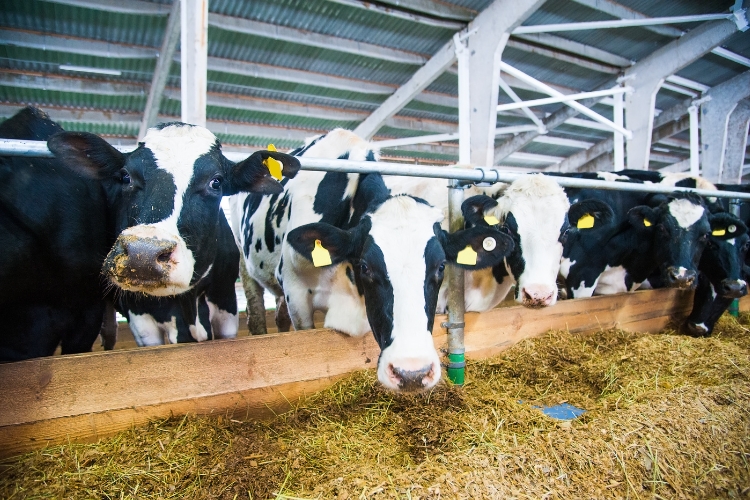
The Role of Technology in Sustainable Dairy Farming
Economic and Social Benefits of Sustainable Dairy Farming
1. Increased Profitability
A sustainable approach to agriculture offers many advantages that can have a positive impact on the economic situation. In addition, sustainably managed farms strengthen their reputation in society and open up new market opportunities for sustainably produced products.
2. Enhanced Brand Reputation
Consumers are increasingly demanding ethically sourced products, and dairy farming must evolve to meet these expectations. Consumers are becoming more conscious of the origins of their food and the impact it has on the environment and animal welfare.
3. Support for Local Communities
Dairy drives local businesses and economies. In the U.S., 94% of dairy farms are family-owned and -operated, contributing to rural economies and supporting over 3 million jobs. Globally, the dairy sector supports about 1 billion livelihoods, all while delivering essential nutrients through a range of tasty foods.
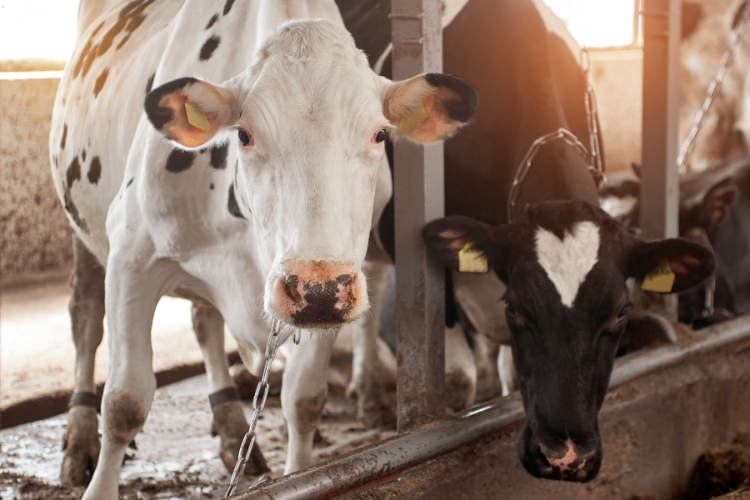
Challenges and Barriers to Sustainability
1. Economic Constraints
Investing in environmentally friendly technologies and practices can be costly at first, discouraging some farmers from adopting them.
These costs include infrastructure modifications such as energy-saving devices and waste management systems, as well as continuous operational costs. Despite the long-term advantages, the initial financial load might be prohibitively expensive for many dairy enterprises.
2. Regulatory Challenges
Dairy farmers confront regulatory challenges in meeting environmental requirements and laws. Compliance frequently necessitates costly changes to reduce environmental effects, such as waste management improvements and emission reduction techniques.
Stricter restrictions need continual investment in compliance procedures, increasing operational costs. Failure to satisfy these standards may result in fines and penalties, aggravating the financial hardship.
3. Knowledge Gaps
There exist knowledge and awareness gaps among dairy farmers about the benefits and best practices for sustainability. Many people may not have access to the information or tools they need to properly comprehend sustainable behaviors.
Educating farmers on the economic and environmental benefits of sustainability is critical. Extension programs, workshops, and collaborations with industry organizations can help close these gaps, equipping farmers to effectively implement sustainable practices.
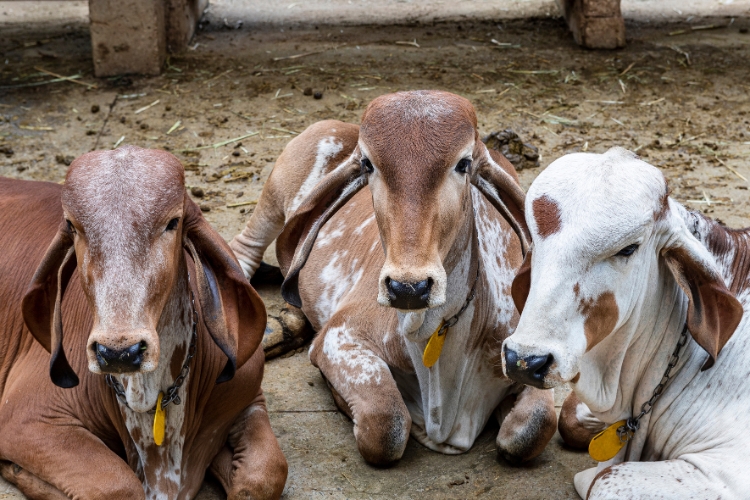
The Future of Sustainable Dairy Farming
As dairy farmers continue to focus on sustainability, the future of the industry is likely to involve the continued use and improvement of the practices covered in this article. Some potential developments include:
- Further advancements in precision agriculture and data-driven decision-making to optimize resource use and minimize environmental impact.
- Widespread adoption of renewable energy sources, such as solar and anaerobic digesters, to power dairy operations.
- Continued research and development of feed additives and strategies to reduce methane emissions from dairy cows.
- Improved water conservation and recycling technologies to minimize water usage and prevent contamination.
- Strengthened partnerships between dairy farmers, consumers, policymakers, and industry stakeholders to drive collective action toward sustainability.
The key to the future of sustainable dairy farming lies in the industry’s ability to balance economic viability, environmental stewardship, and social responsibility. By adopting best practices, embracing technological innovations, and fostering collaborative efforts, dairy farmers can ensure the long-term sustainability of the industry and its positive impact on the planet and local communities.
Conclusion
Sustainability is critical to the dairy industry’s long-term viability in the face of rising environmental concerns and customer demand for ethical manufacturing. Adopting sustainable techniques decreases environmental effects, combats climate change, and preserves natural resources, as well as increases dairy producers’ efficiency and profitability.
It also promotes resilience to external problems such as changing rules and consumer preferences, while also projecting a positive image of the industry.
Think long-term and act sustainably – this is the key to preserving your farm for future generations and ensuring economic success at the same time.
FAQs
1. What are the environmental challenges facing the dairy industry?
The dairy industry faces significant environmental challenges, including greenhouse gas emissions, water use and quality concerns, and the impact of land use on biodiversity. Addressing these issues through sustainable practices like reducing emissions, conserving water, and promoting biodiversity is crucial for the industry’s long-term viability.
2. How can dairy farmers implement sustainable practices?
Dairy farmers can adopt various sustainable practices, such as improving soil health and nutrient management, optimizing manure use for renewable energy and fertilization, managing feed to reduce methane emissions, and implementing water conservation and recycling strategies. Investing in renewable energy sources, like solar power, can also contribute to the sustainability of dairy operations.
3. What is the role of technology in sustainable dairy farming?
Technology plays a vital role in sustainable dairy farming, with advancements in precision agriculture, robotic milking systems, and wearable sensors enabling farmers to optimize resource use, enhance animal welfare, and reduce environmental impact. These data-driven technologies help dairy farmers make informed decisions and implement targeted interventions to improve the overall sustainability of their operations.
4. What are the economic and social benefits of sustainable dairy farming?
Sustainable dairy farming can lead to increased profitability for farmers, as it helps them meet evolving market demands and strengthen their brand reputation. It also supports local communities by contributing to rural economies and providing essential nutrients through dairy products. Additionally, sustainable practices promote animal welfare and environmental stewardship, which aligns with the growing consumer demand for ethically sourced and environmentally friendly food.
